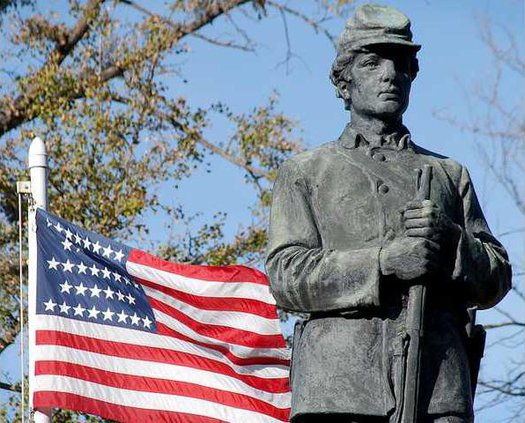The director of the National Park Service’s Monument Research and Preservation Program will inspect the Civil War soldier statue in Barton County’s courthouse square when he visits Great Bend on Monday, Oct. 24. Dr. Dennis Montagna will also speak that evening to the Barton County Historical Society, in a program that will be open to the public.
His topic for the Civil War Sesquicentennial celebration program is "Standing on the Border of Two Worlds: Mourning Our Civil War Dead in Garden Cemeteries." It will be at 7 p.m. on Oct. 24 in the Historical Society’s Ray S. Schulz Research Library. It is in the main building of the Historical Museum and Village, located just south of the Arkansas River bridge on U.S. 281. Montagna’s presentation will feature monuments in Great Bend, Stafford, Hutchinson, Salina, McPherson and other locations across Kansas.
Sculptor Frederick Hibbard’s bronze, "The Rifleman," was installed in Lafayette Park, north of the Barton County courthouse, in 1915 to honor local Civil War veterans.
Kansas, known as "The Soldier State," played a pivotal role before, during, and after the Civil War, said Karen Neuforth, executive director of the Barton Arts Council. Anticipating the sesquicentennial celebration, the Barton County Historical Society and the Arts Council have jointly initiated projects to explore the Civil War themes. Along with the National Park Service event, "The Civil War and The Exodusters in Central Kansas" program has been created, which includes displays and a brochure to highlight the Sparks of Conflict, Western Migration, Honored Memories, and the Exoduster Movement (from Independence to Influence).
Beverly Komarek, executive director of the Barton County Historical Society, noted the museum has been active in promoting the State of Kansas sesquicentennial, and is also ready to observe the Civil War anniversary.
"Dr. Montagna’s presentation and other sesquicentennial projects reflect the communities’ passion and commitment to promote our rich cultural and natural heritage," Komarek said. "We continue the efforts, whether it’s honoring the achievements of Exodusters or the accomplishments of early conservationists like Frank Robl that are making central Kansas a leader in natural resource stewardship and the preservation of our collective heritage."
"With these and other humanities programs like Oscar Micheaux events, central Kansas offers diverse and one-of-a-kind artistic opportunities," Neuforth said. "Dr. Montagna’s program opens a door to the rich legacy of public art; what were once ‘rural’ cemeteries – like Gettysburg and Arlington – became national public spaces where the art of remembrance flourished. Today, a legacy of the garden cemetery is that they still promote a social and artistic consciousness within their communities."
About the program
The movement to design and build large garden cemeteries found its first expressions in large cities in the Eastern United States during the 1830s. A decade later, they were flourishing in the mid-west as well. By the Civil War (1861-1865), these ambitiously designed burial spaces stood ready to play a starring role in remembrance of the hundreds of thousands who went to war but never returned.
Dr. Montagna’s lecture will consider the garden cemetery movement and focus considerable attention on the Civil War and the ways in which cemeteries created only a generation earlier came to the fore as the pre-eminent venues for both private and public remembrance of the human cost of war and its aftermath, including western migration, the Buffalo Soldiers, and Exodusters. Within this national framework, the development of cemeteries in Kansas will be reviewed with the idea of how they met the commemorative needs of young communities.
Nationally, these garden cemeteries, many of which reside near America’s Scenic Byways, the National Park System and the Public/Tribal lands, have come to the forefront once again; the result of current preservation efforts that seek to restore them to a place of prominence for Americans seeking to better understand the nation’s history, and striving to find ways to recreate places where they can establish community with others.





